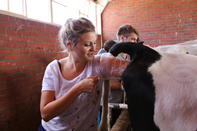After calving, the cow's uterus recovers and shrinks back to its normal size. The time of recovery can range from 25 to 50 days. When the cow experienced difficulty in giving birth, it may lead to infections of her uterus and this may extend the recovery period of the uterus.

Normal heat cycling returns after the recovery of the uterus. Thereafter cows come on heat every 19 to 21 days. Heat cycling involves the development of a follicle in the ovaries to prepare for the discharge of an ovum for fertilization. When no fertilization occurs, the process repeats itself.
There are a number of signs cows show when they are on heat, but the best sign is that they stand still to be serviced by a bull or to be inseminated. Also check for a clear mucus discharge flowing from the vulva. Ovulation (when the follicle erupts releasing the ovum) takes place about 12 hours after the end of the standing heat.
How to Do Artificial Insemination (AI)
While AI is regarded as a simple technique, the correct technique should be followed for each cow. Semen for AI is stored in 0.5 ml plastic straws inside a semen flask (tank) at -196 °C. Some basic steps of AI include the following: thaw semen in a vertical (upright) position in a thermos flask containing warm water at 35 °C.
Remove the straw after about one minute, dry the straw using a paper cloth and put the straw inside a warmed-up insemination rod (pistolet). Cut off the end of the straw to allow semen to be pushed out and put a plastic sheath over the straw and pistolet for protection against pathogens.
Now, put the pistolet into the cow’s vulva and carefully guide it towards and through the cervix and deposit semen just through the cervix. Afterwards, the uterus can be massaged to stimulate the movement of the semen inside the uterus horn.
Keep the cow separate and quiet for a short time after insemination. If insemination was unsuccessful, the cow will be on heat again, 19 to 21 days after her previous heat cycle.
By Dr Carel Muller